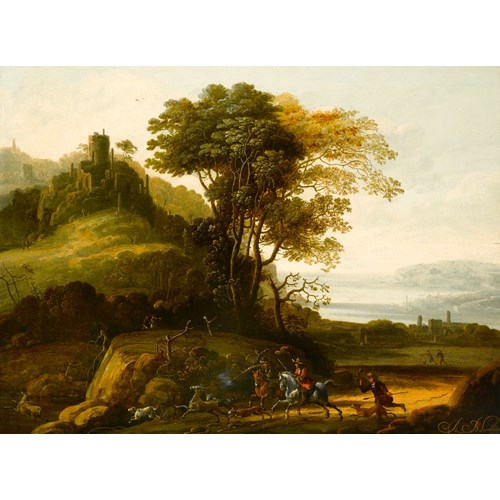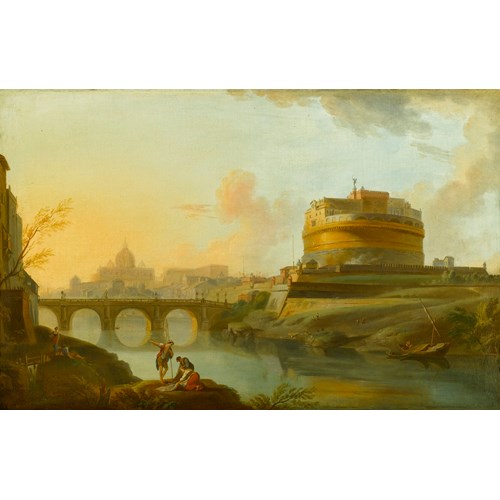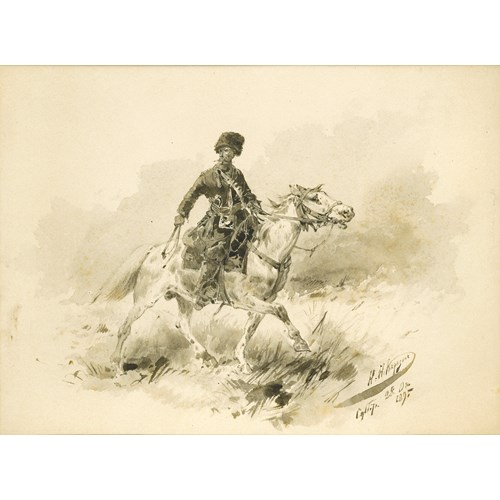Jan van Goyen
A Wooded Landscape with Travellers by the Swan Inn and at another Inn Opposite
Date 1649
Period 1600-1750, 17th century
Origin The Netherlands
Medium Oil on panel
Dimension 27.8 x 37.8 cm (11 x 14⁷/₈ inches)
On the opposite side of the road, another inn - the sign possibly showing a crescent moon - is equally busy. A line of horses quench their thirst from a series of troughs while a cart and figures gather outside. To the left of the composition, under a tall, gnarled oak tree, three figures wait outside a church. Placed beside the seated figure, who wears a black hat, is a white sack possibly identifying the group as itinerant travellers.
The landscape is open and far reaching. In the distance a church spire can just be made out from behind a group of trees that pepper the horizon and the viewer gets a clear sense that these inns are a key post of relaxation and refreshment along a busy rural route.
The present work is dated to 1649 and is an excellent example of Jan van Goyen’s later paintings from the 1640s. These works are characterised particularly by a simplified composition with a very low horizon, looser handling of paint and a stronger focus on light and air. Buildings assume an important role, from churches, castles, ruins, gates and towers to monumental town views.
Moreover, as seen in the present painting, van Goyen’s colouring is more tonal as his palette was limited to ochre and brown shades, blue-grey and yellowish white. The artist applied these colours to the panel with loose, clearly visible brushstrokes to inject a freshness and spontaneity into his work thus creating a heightened sense of space and atmosphere. Another excellent example, epitomising van Goyen’s later works, is now held in the Rijksmuseum, Amsterdam.
In A Landscape with Two Oaks the viewer’s eye is caught immediately by the two trees dominating the foreground, and indeed the entire composition. As in the present work, van Goyen employs a slightly angled foreground to offset the low horizon line and to lead the viewer into the spacious landscape that fills the far distance. Furthermore, the colouring and tonality is similar, especially with his use of a yellowy-brown palette. A real sense of atmosphere is particularly palpable in A Landscape with Two Oaks as the sky is blackening in the distance, while sunshine still falls on the trees.
In the present oil, van Goyen has framed the composition by including several tall, gnarly trees along the roadside; their angular height cuts through the horizontality of the landscape. The addition of dramatic trees as an artistic device is clearly one that van Goyen enjoyed and used frequently, for example in Landscape with Oak. Here again the tree trunk bends under the pressure of the expanding branches above, and the ground underneath bumpily undulates as the oak sets its roots deeper.
Van Goyen was also an avid draughtsman who travelled widely around the Netherlands filling sketchbooks with studies and preparatory drawings of rural and coastal activities to be used in his final paintings.¹ The large body of van Goyen’s drawings that remain today show his great skill at including actual motifs and observations within imaginary landscape compositions. For example, a drawing in the Fitzwilliam Museum attributed to van Goyen focuses on a farmhouse with a water pump. It is very possible that the water pump outside the Swan Inn was included in the present painting after he had spotted a similar scene on his travels. These detailed drawings were then worked up into large oils in his studio and they sought to encapsulate the landscape, and vistas, of his native Holland, for example Winter Scene near The Hague.
Van Goyen was born in Leiden, the son of a cobbler. He was apprenticed from 1606, at the tender age of ten, successively to the Leiden painters Coenraet van Schilperoort (1577-1636), Isaac Claesz. van Swanenburgh (1537-1614), Jan Arentsz. de Man (fl.1587).
Van Goyen spent from 1615 to 1616 travelling around France before returning to Haarlem where he trained for a year with Esaias van de Velde (1587-1630), who strongly influenced his early paintings until about 1626. Van de Velde was the first Dutch painter to abandon the mannerisms of the Flemish style in favour of more naturalistic landscape views. This is particularly evident in van de Velde’s focus on detail, strong spots of colour, and crowded compositions.
Van Goyen’s Landscape with Skaters, is closely comparable to van de Velde’s The Joy of Ice on the Wallgraben. Interestingly van Goyen’s skating scene, painted in 1645, while echoing the composition and subject-matter of his teacher, displays the characteristics associated with his own works in the 1640s for example the very low horizon line, monochromatic tonality and atmospheric lighting.
Around 1626 van Goyen moved past his master’s example and introduced an emphasis on tonality and realism seen in the works of Pieter de Molijn (1595-1661), Salomon van Ruysdael (1600/3-1670) and Pieter Dircksz. van Santvoort (c.1604-1653). Throughout the 1630s, he produced simple landscapes of dunes and rivers in brown and green tones that cleverly achieve a sense of depth with the help of diagonals - for example Shore at Scheveningen. In his later paintings, such as in this work, van Goyen reintroduced travellers, carriages and fishermen to inject an element of animation and activity.
Van Goyen moved to The Hague in 1632, achieving citizenship in 1634. He had three daughters by his wife Anna Willemsdr van Raelst - Maria later married the still life painter Jacques de Claeuw (fl.1642-76) while Margaretha married the genre painter Jan Steen (c.1625-1679). From 1638 to 1640 he was head of the Guild of St. Luke in the city.
Artists were generally poorly paid in the seventeenth century and van Goyen tried to bolster his and his family’s fortunes with various entrepreneurial schemes, some more successful than others. He was intermittently active as an art dealer and collector, auctioneer, estate agent and picture valuer. In 1637 he lost a large amount of money speculating in tulips during the so-called period of ‘tulipomania’. This was a period in the Dutch Golden Age when contract prices for bulbs of the recently introduced tulip reached extraordinarily high levels and then suddenly collapsed. At the peak of tulipmania in February 1637, tulip contracts sold for more than ten times the annual income of a skilled craftsman.
In 1652 and in 1654 these poor investments forced van Goyen to sell his possessions twice at public auction, and after his death two years later, his wife sold their remaining assets and the family house in order to clear his debts.
Van Goyen had several students including his son-in-law Jan Steen (c.1625-1679), Nicholaes Berchem (1620-1683) and Adriaen van der Cabel (1630/1-1705) and many other artists were influenced by his compositions, painting style and draughtsmanship.
¹ Drawings are datable to every year of van Goyen’s career and he was particularly prolific in 1631, 1647, 1649 and from 1651 to 1653.
Date: 1649
Period: 1600-1750, 17th century
Origin: The Netherlands
Medium: Oil on panel
Signature: The present work has a certificate, dated October 1927, by C. Hofstede de Groot, attached to the reverse with wax seals.
Dimension: 27.8 x 37.8 cm (11 x 14⁷/₈ inches)
Provenance: with P. de Boer, Amsterdam, 1926-7;
Anonymous sale; Frederik Muller, Amsterdam, 31 May 1949, lot 30 (Dfl. 4,600);
E. Cancrinus, Haarlem; Christie's, London, 14 May 1954, lot 130;
with Sant Lucas, The Hague;
J.F. ten Bos, Almelo;
L. van Hoecken, Wassenaar; Paul Brandt, Amsterdam, 24 June 1959, lot 192 (Dfl. 26,000);
Gerhard Schoeller, Burg Gretesch, Osnabrück, and by descent to the previous owner.
Literature: H.-U. Beck, Jan van Goyen, Amsterdam, 1973, II, p. 464, no. 1036.
More artworks from the Gallery









